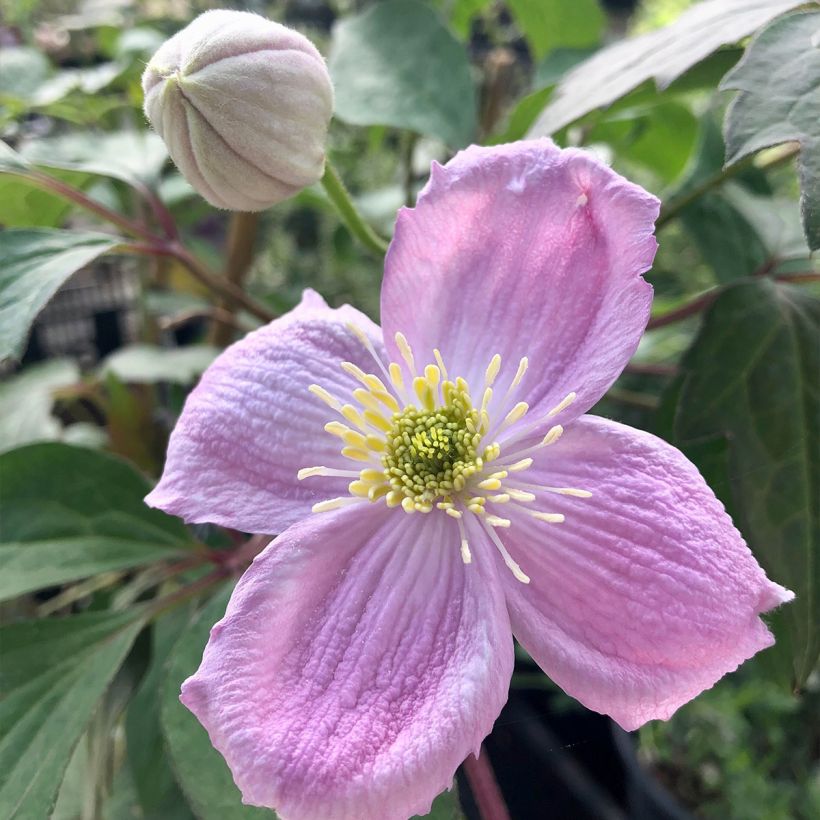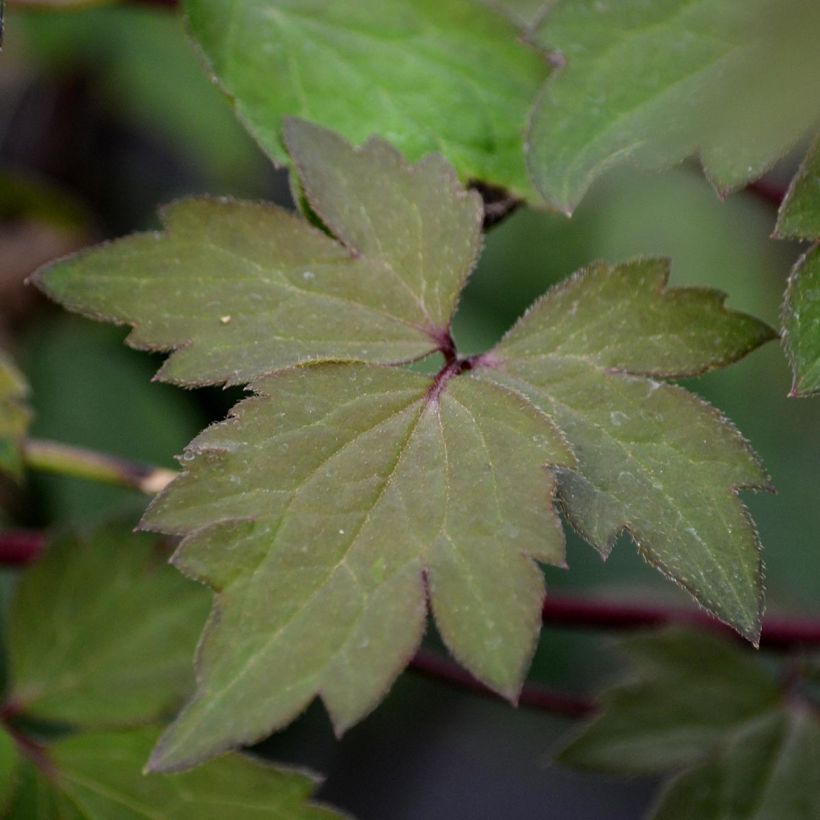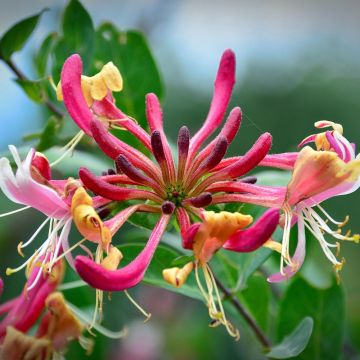

Clematis Sanssouci


Clematis Sanssouci


Clematis Sanssouci


Clematis Sanssouci
View more pictures
Hide images

Claude B.

Lovely.
Claude B. • 63 FR
Clematis Sanssouci
Clematis x montana Sanssouci
Montana Clematis
Planted a year ago, it fills the terrace with a delightful fragrance, a true pleasure.
Elisabeth, 14/06/2021
Special offer!
Receive a €20 voucher for any order over €90 (excluding delivery costs, credit notes, and plastic-free options)!
1- Add your favorite plants to your cart.
2- Once you have reached €90, confirm your order (you can even choose the delivery date!).
3- As soon as your order is shipped, you will receive an email containing your voucher code, valid for 3 months (90 days).
Your voucher is unique and can only be used once, for any order with a minimum value of €20, excluding delivery costs.
Can be combined with other current offers, non-divisible and non-refundable.
Home or relay delivery (depending on size and destination)
Schedule delivery date,
and select date in basket
This plant carries a 6 months recovery warranty
More information
We guarantee the quality of our plants for a full growing cycle, and will replace at our expense any plant that fails to recover under normal climatic and planting conditions.

Would this plant suit my garden?
Set up your Plantfit profile →
Description
'Sanssouci' Clematis is a brand new variety of Clematis montana that comes to us from Germany: it is named after the former summer residence of King Frederick II of Prussia, the Sanssouci Palace. It is often described as a smaller but more floriferous version of 'Tetrarose', with early spring flowering in a deep pink-lilac shade, and the scent of carnation, as well as its beautiful bronze-green foliage. This lovely hardy climber is better suited to small spaces and perfect for romantic or English gardens. It thrives in full sun or partial shade, in moist, deep, fertile soil, and even in a medium altitude garden.
Clematis 'Sanssouci' is a semi-woody, climbing perennial plant belonging to the Ranunculaceae family, introduced in Germany in 2012. This variety will reach 4 to 5m (13 to 16ft) high in a few years, with a minimum spread of 2m² (21.5sq ft). It is derived from the Clematis montana, native to the Himalayas, an excellent garden plant extensively used in many regions. Like its parent, it does not require pruning, or only to reduce its height to 2m (7ft), after flowering.
This Clematis produces small, single flowers with a diameter of 4 to 6 cm (1.6 to 2in), which bloom abundantly in April-May. The flowers are grouped in axillary clusters of 1 to 5 flowers on long pedicels on the previous year's branches. They have 4 round to ovate tepals, gracefully open in a star shape with a yellow stamen centre. Their colour is a shade of lilac-tinged pink, and their spicy and sweet fragrance resembles carnations. The flowers are followed by decorative, feathery, grayish-silver seed heads. The leaves are simple, palmate, with irregularly toothed edges, reddish when young, then bronze green, in perfect harmony with the slightly faded pink flowers. This Clematis attaches itself to a support or host plant through twining petioles transformed into tendrils.
Plant Clematis montana alongside your climbing roses to extend the flowering of your walls and pergolas until the end of summer. The Clematis genus is rich in diversity, with varieties available in all colours, shapes, and sizes, suitable for experienced gardeners and beginners. Choose one of these beautiful climbers to give your garden a romantic and bohemian touch. 'Sanssouci', a true spring joy, easily fits in a modest-sized garden, for example on a trellis, ballustrade, pergola, or in a hedge. It makes a perfect gift for a gardening friend.
Tips: Avoid excessive fertiliser that stimulates foliage growth at the expense of flowers. Do not mulch, as excessive moisture can promote clematis wilt.
Report an error about the product description
Clematis Sanssouci in pictures




Plant habit
Flowering
Foliage
Botanical data
Clematis
x montana
Sanssouci
Ranunculaceae
Montana Clematis
Cultivar or hybrid
Other Clematis Montana
View all →Planting and care
Choose a sunny or partially shaded exposure. In sunny exposure, shade the base of your plant with a ground cover plant or perennial geranium. Clematis plants like to have their feet in the shade. Plant your clematis by covering the root ball with 3 cm (1in) of soil, in soil worked to a depth of 20 cm (8in), lightened with good compost. Water well for the first few weeks. Clematis plants cling on their own thanks to their tendrils. To promote their growth, provide them with trellis support or help them dress the trunk of a tree by placing a wire mesh. Clematis plants also like to grow freely on neighbouring plants. You can prune it in June down to 1m (3ft). Do not overwater, as stagnant water can promote fungal disease at the base of the plants.
Planting period
Intended location
Care
-
, onOrder confirmed
Reply from on Promesse de fleurs
Similar products
Haven't found what you were looking for?
Hardiness is the lowest winter temperature a plant can endure without suffering serious damage or even dying. However, hardiness is affected by location (a sheltered area, such as a patio), protection (winter cover) and soil type (hardiness is improved by well-drained soil).

Photo Sharing Terms & Conditions
In order to encourage gardeners to interact and share their experiences, Promesse de fleurs offers various media enabling content to be uploaded onto its Site - in particular via the ‘Photo sharing’ module.
The User agrees to refrain from:
- Posting any content that is illegal, prejudicial, insulting, racist, inciteful to hatred, revisionist, contrary to public decency, that infringes on privacy or on the privacy rights of third parties, in particular the publicity rights of persons and goods, intellectual property rights, or the right to privacy.
- Submitting content on behalf of a third party;
- Impersonate the identity of a third party and/or publish any personal information about a third party;
In general, the User undertakes to refrain from any unethical behaviour.
All Content (in particular text, comments, files, images, photos, videos, creative works, etc.), which may be subject to property or intellectual property rights, image or other private rights, shall remain the property of the User, subject to the limited rights granted by the terms of the licence granted by Promesse de fleurs as stated below. Users are at liberty to publish or not to publish such Content on the Site, notably via the ‘Photo Sharing’ facility, and accept that this Content shall be made public and freely accessible, notably on the Internet.
Users further acknowledge, undertake to have ,and guarantee that they hold all necessary rights and permissions to publish such material on the Site, in particular with regard to the legislation in force pertaining to any privacy, property, intellectual property, image, or contractual rights, or rights of any other nature. By publishing such Content on the Site, Users acknowledge accepting full liability as publishers of the Content within the meaning of the law, and grant Promesse de fleurs, free of charge, an inclusive, worldwide licence for the said Content for the entire duration of its publication, including all reproduction, representation, up/downloading, displaying, performing, transmission, and storage rights.
Users also grant permission for their name to be linked to the Content and accept that this link may not always be made available.
By engaging in posting material, Users consent to their Content becoming automatically accessible on the Internet, in particular on other sites and/or blogs and/or web pages of the Promesse de fleurs site, including in particular social pages and the Promesse de fleurs catalogue.
Users may secure the removal of entrusted content free of charge by issuing a simple request via our contact form.
The flowering period indicated on our website applies to countries and regions located in USDA zone 8 (France, the United Kingdom, Ireland, the Netherlands, etc.)
It will vary according to where you live:
- In zones 9 to 10 (Italy, Spain, Greece, etc.), flowering will occur about 2 to 4 weeks earlier.
- In zones 6 to 7 (Germany, Poland, Slovenia, and lower mountainous regions), flowering will be delayed by 2 to 3 weeks.
- In zone 5 (Central Europe, Scandinavia), blooming will be delayed by 3 to 5 weeks.
In temperate climates, pruning of spring-flowering shrubs (forsythia, spireas, etc.) should be done just after flowering.
Pruning of summer-flowering shrubs (Indian Lilac, Perovskia, etc.) can be done in winter or spring.
In cold regions as well as with frost-sensitive plants, avoid pruning too early when severe frosts may still occur.
The planting period indicated on our website applies to countries and regions located in USDA zone 8 (France, United Kingdom, Ireland, Netherlands).
It will vary according to where you live:
- In Mediterranean zones (Marseille, Madrid, Milan, etc.), autumn and winter are the best planting periods.
- In continental zones (Strasbourg, Munich, Vienna, etc.), delay planting by 2 to 3 weeks in spring and bring it forward by 2 to 4 weeks in autumn.
- In mountainous regions (the Alps, Pyrenees, Carpathians, etc.), it is best to plant in late spring (May-June) or late summer (August-September).
The harvesting period indicated on our website applies to countries and regions in USDA zone 8 (France, England, Ireland, the Netherlands).
In colder areas (Scandinavia, Poland, Austria...) fruit and vegetable harvests are likely to be delayed by 3-4 weeks.
In warmer areas (Italy, Spain, Greece, etc.), harvesting will probably take place earlier, depending on weather conditions.
The sowing periods indicated on our website apply to countries and regions within USDA Zone 8 (France, UK, Ireland, Netherlands).
In colder areas (Scandinavia, Poland, Austria...), delay any outdoor sowing by 3-4 weeks, or sow under glass.
In warmer climes (Italy, Spain, Greece, etc.), bring outdoor sowing forward by a few weeks.


















































